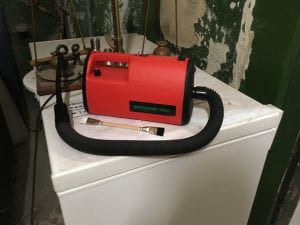Caroleen Molenaar (BA Fashion and Dress History) and Emmy Sale (MA History of Design and Material Culture) reflect on the skills they have acquired on the job.
The Old Police Cells Museum opened in 2005 as a mayoral project instigated by Brighton Councillor Pat Drake. It was initially run by a dedicated and knowledgeable team of volunteers and ex-police staff. In 2018, the museum entered a new phase. MA History of Design and Material culture alumnus, e-j scott, was hired as the curator with a mission to help the museum achieve national accreditation status. As part of this process of development, volunteers were recruited to work to improve the museum to the standard required.
Caroleen Molenaar, BA (Hons) Fashion and Dress History
When I started my volunteer position at the Old Police Cells Museum in October 2018, I was assigned to be a part of the Costume Collection Team due to my experience, knowledge, and interest in fashion history and wanting to acquire hands-on museum experience.
Within this role I have had a variety of different tasks to complete. In the autumn, along with other Costume Team volunteers, I was responsible for a collection audit of all the costume-related objects that were located within the women’s cells. (At the moment the objects in the women’s cells are not strictly related to women’s policing but encompass both men’s and women’s policing. The name of the women’s cells originates from when the museum was used as a cell and both women and children were held in that part of the building.) This duty included completing accession forms for all items on display and checking in the collections database that all objects on display had been accounted for. Various types of objects were included: men’s and women’s uniforms, police helmets, handcuffs, buttons, epaulettes, whistles, belts, and truncheons.
Since January 2019 my role has shifted into another aspect of collections management. Alongside other volunteers, I have begun to conserve the police uniforms within the collection. This type of conservation is a multi-step process that takes place over several weeks. It involves wrapping the police uniforms in plastic for protection; placing them in a large freezer for two to three weeks to kill any bugs or bacteria that may be on the uniform; unwrapping the uniforms; cleaning the uniforms which a specific conservation vacuum (Figure 1); wrapping them in acid-free tissue paper; and storing them in plastic storage boxes. Condition reports, which include information such as markings, measurements, and overall garment condition, as well as accession forms are completed for each object.
My volunteer position at the Old Police Cells Museum has provided me with invaluable hands-on skills and knowledge about costume collection management within a museum environment. This will be invaluable when pursuing future employment within the sector.
Emmy Sale, MA History of Design and Material Culture
I became involved with the Old Police Cells Museum as a way to gain first-hand experience in a museum environment and to apply the theoretical thinking about museum displays from seminar discussions into practice. The role assigned to me was object and displays researcher for the women’s cell. This includes producing informative A1 text panels alongside displays of objects and images from the museum collection that tell the history of women police in Sussex.

Screenshot from “U.K.: London Policewomen Get A New Uniform.” 1967. British Pathé. https://www.britishpathe.com/video/VLVAA0A0KX6PDW06WVAAKHN7FFVPE-UK-LONDON-POLICEWOMEN-GET-A-NEW-UNIFORM/query/women+police
I was keen to produce a display about women’s uniform and was delighted to find out that not only had celebrated couturier Norman Hartnell designed a women’s police uniform in 1967 but that the museum has an example of the hat that was part of this uniform. A British Pathé video of the press day (Figure. 2), revealed how they wanted to contrast the new ‘modern’ Hartnell-designed uniform with the uniform previously worn. We were able to translate this comparison into a display with both hats mounted in a cabinet alongside a text panel (Figure 3), explaining the significance of Hartnell’s role and how his design was unfortunately unsuccessful due to some impracticalities in its tailoring.

Figure 3: Display about the 1967 women’s police uniform designed by Norman Hartnell. Old Police Cells Museum, Brighton. Photograph by Emmy Sale, 30 March 2019.
The role has offered useful insight into the challenges of working with a museum wanting to achieve accreditation, particularly in terms of appropriate word counts for text panels and copyright issues surrounding the use of images. Research into police history was not something I had undertaken before but it has been an exciting challenge that tests my research skills and the application of them to new subjects. My next project for the women’s cell is to produce a timeline charting the history of women in Sussex-based police services since 1915.

